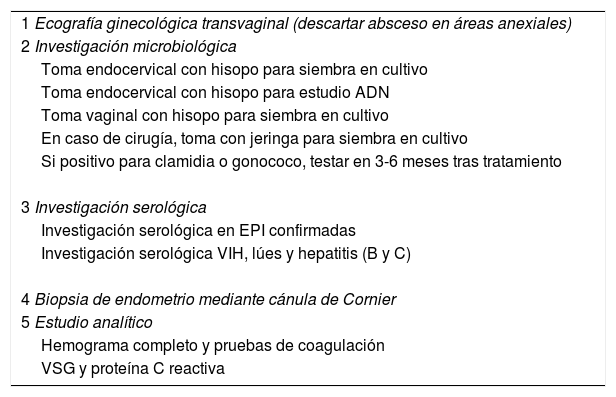Estudiar los factores de riesgo y la relación entre los hallazgos clínico-ecográficos y los hallazgos microbiológicos y anatomopatológicos en el contexto de una enfermedad pélvica inflamatoria.
Material y métodosEstudio observacional retrospectivo realizado entre enero de 2010 y noviembre de 2015. Se incluyó a aquellas pacientes con diagnóstico de enfermedad pélvica inflamatoria registradas en la base de datos informatizada del Servicio de Obstetricia y Ginecología del Complejo Hospitalario Universitario Insular Materno-Infantil y con criterios para ser hospitalizadas. Se excluyeron las pacientes tratadas de forma ambulatoria.
ResultadosSe obtuvo una muestra de 112 pacientes con una edad media de 35,4 años. Solamente el 11,6% cumplían todos los criterios mínimos de diagnóstico de enfermedad pélvica inflamatoria. Los patógenos aislados en mayor porcentaje fueron clamidia y gonococo. Se hizo biopsia de endometrio en un 55,6% de los casos y la ecografía informó de una imagen sugestiva de EPI en un 56,3%. La pauta antibiótica más empleada fue la asociación de clindamicina y gentamicina. Se instauró tratamiento de la pareja sexual en el 48,2% de los casos. El 82,15% de las pacientes recibieron tratamiento quirúrgico.
ConclusiónLa población estudiada es atípica en cuanto a edad media y factores de riesgo, aunque la recogida de datos en la anamnesis es mejorable. La incidencia de gonorrea ha disminuido en nuestro medio, coincidiendo con la aparición de nuevos patógenos que adquieren mayor importancia. Se debe insistir en la toma de biopsia de endometrio para aumentar el índice de sospecha y en la realización del tratamiento a la pareja sexual. Aun así, los resultados del tratamiento hospitalario y quirúrgico fueron favorables.
To analyse the risk factors and the relationship between clinical and sonographic findings and microbiological and pathological findings in the context of pelvic inflammatory disease.
Materials and methodsRetrospective observational study conducted between January 2010 and November 2015. Patients with a diagnosis of pelvic inflammatory disease, registered in the electronic database of the Department of Obstetrics and Gynaecology of Complejo Hospitalario Universitario Insular Materno-Infantil, who met the hospitalisation criteria for the Gynaecology Department, were selected. Patients treated on an outpatient basis were excluded.
ResultsA sample of 112 patients was obtained, with a mean age of 35.4 years. Only 11.6% of patients met all minimum diagnosis criteria of pelvic inflammatory disease. Chlamydia and gonorrhoea were the most frequently isolated pathogens. Endometrial biopsy was performed in 55.6% of the cases, while ultrasonography showed images suggestive of pelvic inflammatory disease in 56.3% of the patients. The combination of clindamycin and gentamicin was the most used antibiotic regimen, with 48.2% of sexual partners being treated. A number of 82.15% of patients underwent surgery.
ConclusionThe study population is atypical in terms of average age and risk factors, although there is room for improvement in relation to data collected from the patients’ medical history. The incidence of gonorrhoea has declined in our area, which is consistent with the emergence of new pathogens that are more prevalent. Endometrial biopsy should be performed to increase the index of suspicion and the treatment of sexual partners. On the whole, however, the hospital and surgical treatment results were favourable.









